The Innovative Brand Making Hair Extensions Work for Fine and Thinning Hair
If you have fine hair, thinning hair or a combination of the two, you arguably stand to benefit most from the added length, volume and fullness hair extensions provide. But the ironic, unfortunate truth is that the majority of options on the market simply aren't made for you.
Many of the most widely used hair extensions are heavy, meaning they can weigh down fine hair types and even cause damage by pulling on delicate, breakage-prone strands. Beyond that, the adhesives and hot tools that "bond" extensions to hair can be harsh; if the wind blows or hair settles in the wrong way, it can be difficult to disguise them, especially without a thick layer of natural hair on top to cover up the roots.
Voël, a hair extensions company founded by veteran hairstylist Kim Gueldner, is on a mission to mitigate these common problems. Having spent years working with performers on major world tours (including Gwen Stefani, Faith Hill and Katy Perry) as well as on set with celebrities like Amy Schumer, Gueldner has used just about every type of extension and hairpiece firsthand. She also spent years coming to truly understand their shortcomings, particularly for people with fine hair textures.
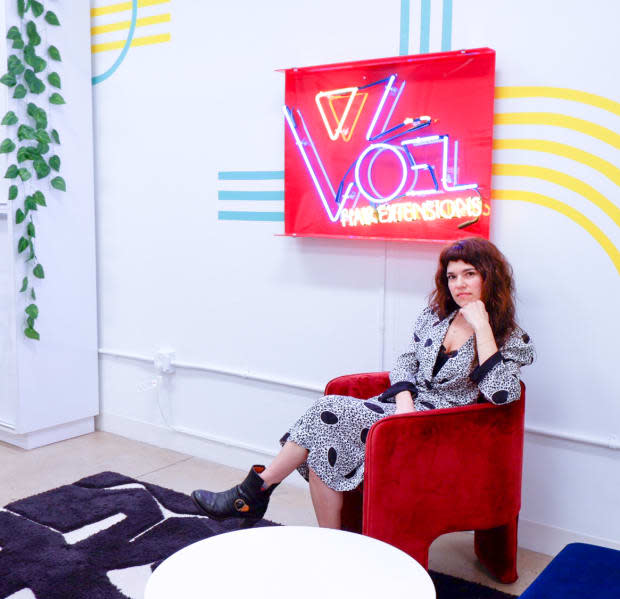
Photo: Courtesy of Voël
Over the course of her career, Gueldner developed, as she spells out on Voël's website, "a love-hate relationship with extensions: loved the idea; hated the way they looked." As anyone who has watched even small amount of reality TV knows all too well, the truest marker of bad hair extensions is that they're obvious.
"I really became obsessed with making hair pieces look natural, because my eye is drawn to a bad hair extension on TV or in a music video," Gueldner tells Fashionista. "I found that a lot of extensions didn't look natural, and that's what I really wanted to change."
After spending a decade assisting Danilo and traveling the world with the aforementioned musical artists, Gueldner moved to New York City, where she built a clientele at Rita Hazan's Upper East Side salon. It was during her time there that she began to understand the scope of the demand for hair extensions among those with fine hair.
"All of my clients [at Rita Hazan] had really fine hair, and they kept asking me for extensions, but I would tell them, 'It could break your hair because your hair is so fine!'" recalls Gueldner. "I was like, this is wild that there's not an extension that I can use on my clients."
So, she set out to create her own version that would seamlessly blend into thin textures without damaging the hair, and the Voël system was born. Six years and her own New York City salon later, Gueldner is now growing a business around her specialized hand-tied microbeaded wefts.
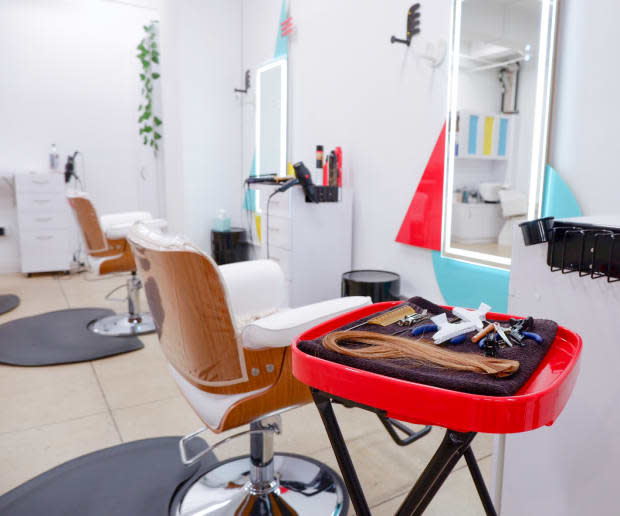
Photo: Courtesy of Voël
What Makes Voël's Hair Extensions Different
One of the most obvious differences between Voël extensions and traditional ones is that Voël's do not require glue, tape or heat for application. "I didn't want to use any adhesives or tapes to attach the hair because that can cause a lot of breakage. If you don't remove it properly, it can take out a lot of hair," explains Gueldner.
Beyond protecting hair health, avoiding these elements is also more sustainable, she notes. Voël's hair can last up to twice as long as other hair extensions (it can be re-used for up to a year, according to Gueldner), and because there's no adhesive involved, it can also be re-used more easily and efficiently than others (which can require tedious cleaning to remove and re-apply the adhesive). The no-tape system also makes the Voël application method far more efficient than other hair extensions. (According to the brand, applying its wefts requires only about half the time of traditional extensions.)
Instead of adhesive, Gueldner relies on a series of tiny metal "microbeads," through which she threads the hair before crimping them on with special pliers. This technique isn't entirely unique to Voël; beaded extensions are somewhat common, and Gueldner's assistant initially introduced her to it as a less-damaging application method. But combined with the company's unique individual wefts — for which Gueldner holds a design patent — they're a game changer.
Voël's wefts take into account what pretty much every other hair extension on the market does not: the fact that not everyone's head can support the addition of giant, heavy swaths of hair. Gueldner began to play around with various types of hair at the salon, creating her own bespoke wefts that both incorporate less hair (as in, fewer strands per weft) and less density (as in, wefts made from thinner strands) than typical extensions.
"I thought about it as matching the hair density that [clients] already have, and then just adding more of that same hair density, instead of adding a big chunk of hair that doesn't match. For someone that has fine hair, that's what makes [most hair extensions] look so unnatural," explains Gueldner.
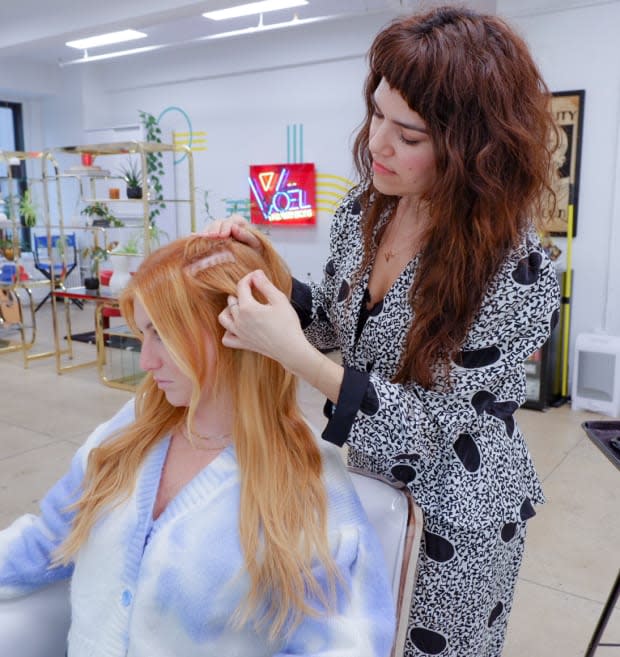
Photo: Courtesy of Voël
The result is a weft that's lightweight and less taxing on fine hair — but another added benefit is that because it so closely matches the wearer's natural texture, it's also likely to air-dry, style and even color in the same ways as the natural hair. This, of course, is convenient for clients, and it also makes for an overall more seamless appearance.
While most hair extensions are all about adding dramatic length to hair, Voël's emphasis is largely on creating fullness and filling in sparse ends — subtly. "My clients are looking for fullness, sometimes more so than length," says Gueldner. "I have a lot of clients who work in corporate, and they don't want to necessarily draw attention to themselves with super long hair or have people notice that they got hair extensions. They want to be discreet, but they still want to feel better about themselves and just have more hair. I also [work with] a lot of women who have hair loss, and so they're great for that, because it doesn't bring attention to the hair loss that you have."
Hair extensions technology and quality have come a long way in the past decade, says Gueldner, but she considers her own system more game-changing than any other recent innovation in the space.
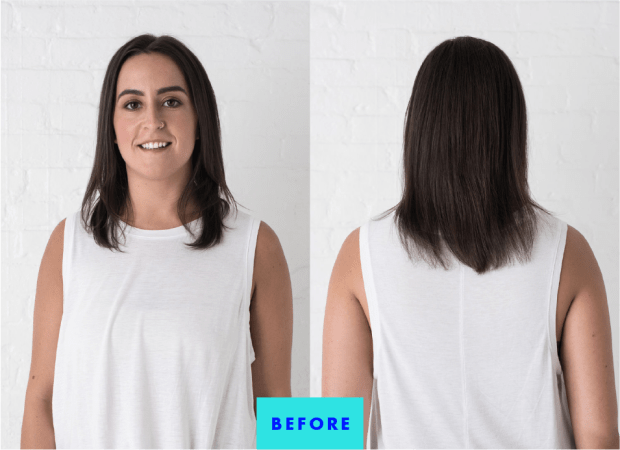
Photo: Courtesy of Voël
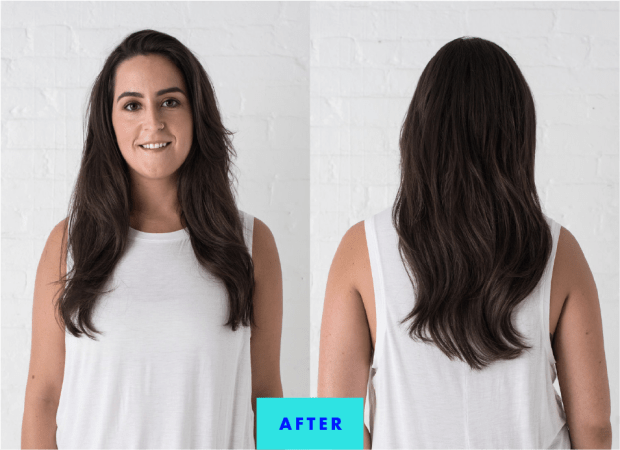
Photo: Courtesy of Voël
Turning Voël from a product into a business
"I did not go to business school. I went to beauty school, so [starting my own business] was not something I would ever think I would or could do," says Gueldner. But she comes from a family of entrepreneurs and describes herself as a "problem solver" and "an idea man," so once she made it through the prototype phase of developing her own extensions, she knew finding ways to distribute them was next.
"My first step was that I got lawyers because I was like, if I'm going to do this, I have to do it right. My biggest fear was getting this out on the market and then someone just stealing it and all of my hard work just going away in a second," she says. "I got trademarked and patented and did all of those corporate things that you're supposed to do to protect yourself."
Self-funding the small business, Gueldner began selling the extensions directly to other professional hairstylists, traveling around the country to hair shows and salons, introducing the product and teaching the application technique. Spreading the Voël Gospel in a small, grassroots way was highly intentional: "I didn't have factories to be able to immediately scale and make a ton, and I didn't want people to misuse them and then blame the company. So I thought it was smarter to be able to control the distribution and make sure people knew how to use it and knew what it was for," she says.
Then came the pandemic. "When the pandemic hit, I made an online course, and it was successful — but when things started to bounce back, I realized I really missed working in the salon," says Gueldner. At that point, Voël was also garnering more interest due to word of mouth and social media. "The next natural step was to open a salon, so that I could have a home base and a flagship where people can come here and get them done anytime they want," she says. She opened the Voël Hair Studio on 8th Avenue in Manhattan in 2022.
What's Next
A considered, slow-but-steady approach seems to guide Gueldner — along with a deep-rooted belief in the product she created and its potential to become a phenomenon. "I think having patience to grow a company is really important," says Gueldner. "I mean, even Jeff Bezos took 20 years to build Amazon to what it is."
"I don't have the manpower to blow up overnight anyway," she adds. "In the hair industry, our best advertisement is word of mouth, always. And I think it's the same with this company."
Gueldner's current short-term goals for the business are simple: "Right now I want to get more clients in the space and continue to create more demand," she tells Fashionista, adding that she's not ready to give up the salon life any time soon.
But looking toward the future, the founder has aspirations that are bigger — just not too big. "My long-term goal would be to open a factory [in the U.S.] where I am making [the extensions] and selling them on a national scale," she says. Why not global? "I want to stay national. I just see so many companies that don't profit because they want to open 80 stores, the goal is just to do the most as soon as possible — and I don't think that's good for business," she says. "I just want to keep it cute."
Want more Fashionista? Sign up for our daily newsletter and get us directly in your inbox.
